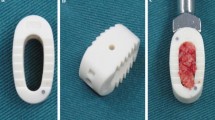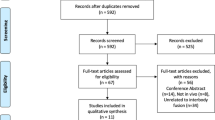Abstract
Purpose
This study aims to compare the early subsidence rate (6–12 months) of standalone novel 3D-printed titanium (Ti) versus polyetheretherketone (PEEK) interbody cages after lateral lumbar interbody fusion (LLIF).
Method
A retrospective study of 113 patients (186 levels) who underwent LLIF surgery with Ti or PEEK cages was conducted. Early subsidence was measured in each treated level using the Marchi et al. classification in radiographs or CT scans acquired at 6–12 months follow-up. Multivariate logistic regression analyses with generalized mixed models, setting subsidence as the outcome variable and including cage type (Ti vs PEEK) as well as significant and trending variables (p < 0.10) in univariate analyses, were conducted.
Results
In total, 51 female and 62 male patients were analyzed. The median [IQR] age at surgery was 60.0 [51.0–70.0] years. Of the 186 levels, 119 levels were treated using PEEK and 67 levels with Ti cages. The overall subsidence rate for Grades I-III was significantly less in the Ti versus the PEEK group (p = 0.003). For high-grade subsidence (Grade II or III), Ti cages also demonstrated a subsidence rate (3.0%) that was significantly less compared to PEEK cages (18.5%) (p = 0.002). Multivariate analysis showed that patients treated with Ti cages were less likely to develop severe subsidence compared to those treated with PEEK (OR = 0.05, 95% CI = 0.01, 0.30) (p = 0.001).
Conclusion
Our study demonstrated that 3D-printed novel Ti cages had a significantly lower early subsidence rate compared to PEEK cages in standalone LLIF patients.
Similar content being viewed by others
Code availability
N/A.
Availability of data and material
The datasets generated during and/or analyzed during the current study are available from the corresponding author on reasonable request.
References
Ozgur BM, Aryan HE, Pimenta L, Taylor WR (2006) Extreme lateral interbody fusion (XLIF): a novel surgical technique for anterior lumbar interbody fusion. Spine J 6:435–443
Rentenberger C et al (2020) Perioperative risk factors for early revisions in stand-alone lateral lumbar interbody fusion. World Neurosurg 134:e657–e663
Salzmann SN, Shue J, Hughes AP (2017) Lateral lumbar interbody fusion—outcomes and complications. Current Rev Musculoskeletal Med 10:539–546
Smith WD, Christian G, Serrano S, Malone KT (2012) A comparison of perioperative charges and outcome between open and mini-open approaches for anterior lumbar discectomy and fusion. J Clin Neurosci 19(5):673–680
Campbell PG et al (2020) PEEK versus titanium cages in lateral lumbar interbody fusion: a comparative analysis of subsidence. Neurosurg Focus 49(3):1–9
Pimenta L, Turner AWL, Dooley ZA, Parikh RD, Peterson MD (2012) Biomechanics of lateral interbody spacers: going wider for going stiffer. Sci World J 2012:1–8
Okano I et al (1020) The association between endplate changes and risk for early severe cage subsidence among standalone lateral lumbar interbody fusion patients. Spine (Phila Pa 1976) 45(23):E1580–E1587
Marchi L, Abdala N, Oliveira L, Amaral R, Coutinho E, Pimenta L (2013) Radiographic and clinical evaluation of cage subsidence after stand-alone lateral interbody fusion. J Neurosurg Spine 19(1):110–118
Krafft PR, Osburn B, Vivas AC, Rao G, Alikhani P (2020) Novel titanium cages for minimally invasive lateral lumbar interbody fusion: First assessment of subsidence. Spine Surg Relat Res 4(2):171–177
Chatham LS, Patel VV, Yakacki CM, Dana Carpenter R (2017) Interbody spacer material properties and design conformity for reducing subsidence during lumbar interbody fusion. J Biomech Eng 139(5):1–8
McGilvray KC et al (2018) Bony ingrowth potential of 3D-printed porous titanium alloy: a direct comparison of interbody cage materials in an in vivo ovine lumbar fusion model. Spine J 18(7):1250–1260
Willems K, Lauweryns P, Verleye G (2019) Randomized controlled trial of posterior lumbar interbody fusion with Ti- and CaP-nanocoated polyetheretherketone cages: comparative study of the 1-year radiological and clinical outcome. Sci World J 13(6):575–587
Najeeb S et al (2016) Bioactivity and osseointegration of peek are inferior to those of titanium : a systematic review. J Oral Implantol XLII:512–516
Tan JH, Cheong CK, Hey HWD (2021) Titanium (Ti) cages may be superior to polyetheretherketone (PEEK) cages in lumbar interbody fusion: a systematic review and meta-analysis of clinical and radiological outcomes of spinal interbody fusions using Ti versus PEEK cages. Eur Spine J 2:1–11
Shepherd JA, Schousboe JT, Broy SB, Engelke K, Leslie WD (2015) Executive summary of the 2015 ISCD position development conference on advanced measures from DXA and QCT: fracture prediction beyond BMD. J Clin Densitom 18(3):274–286
Brown JK et al (2017) Asynchronously calibrated quantitative bone densitometry. J Clin Densitom 20(2):216–225
Kwon AJ, Hunter WD, Moldavsky M, Salloum K, Bucklen B (2016) Indirect decompression and vertebral body endplate strength after lateral interbody spacer impaction: cadaveric and foam-block models. J Neurosurg Spine 24(5):727–733
Frisch RF, Luna IY, Brooks DM, Joshua G, O’Brien JR (2018) Clinical and radiographic analysis of expandable versus static lateral lumbar interbody fusion devices with two-year follow-up. J Spine Surg 4(1):62–71
McGilvray KC et al (2017) Evaluation of a polyetheretherketone (PEEK) titanium composite interbody spacer in an ovine lumbar interbody fusion model: biomechanical, microcomputed tomographic, and histologic analyses. Spine J 17(12):1907–1916
Massaad E, Fatima N, Kiapour A, Hadzipasic M, Shankar GM, Shin JH (2020) Polyetheretherketone versus titanium cages for posterior lumbar interbody fusion: meta-analysis and review of the literature. Neurospine 17(2):473
Han CM et al (2010) The electron beam deposition of titanium on polyetheretherketone (PEEK) and the resulting enhanced biological properties. Biomaterials 31(13):3465–3470
Vadapalli S et al (1976) (2006) “Biomechanical rationale for using polyetheretherketone (PEEK) spacers for lumbar interbody fusion—a finite element study”, Spine (Phila. Pa 31(26):992–998
Seaman S, Kerezoudis P, Bydon M, Torner JC, Hitchon PW (2017) Titanium vs. polyetheretherketone (PEEK) interbody fusion: Meta-analysis and review of the literature. J Clin Neurosci 44:23–29
Phan K, Hogan JA, Assem Y, Mobbs RJ (2016) PEEK-Halo effect in interbody fusion. J Clin Neurosci 24:138–140
Olivares-Navarrete R et al (2012) Osteoblasts exhibit a more differentiated phenotype and increased bone morphogenetic protein production on titanium alloy substrates than on poly-ether-ether-ketone. Spine J 12(3):265–272
Stenport VF, Johansson CB (2008) Evaluations of bone tissue integration to pure and alloyed titanium implants. Clin Implant Dent Relat Res 10(3):191–199
Wu SH et al (2013) Porous titanium-6 aluminum-4 vanadium cage has better osseointegration and less micromotion than a poly-ether-ether-ketone cage in sheep vertebral fusion. Artif Organs 37(12):E191–E201
Huiskes R, Weinans H, Van Rietbergen B (1992) The relationship between stress shielding and bone resorption around total hip stems and the effects of flexible materials. Clin Orthop Relat Res 274:124–134
Arts M, Torensma B, Wolfs J (2020) Porous titanium cervical interbody fusion device in the treatment of degenerative cervical radiculopathy; 1-year results of a prospective controlled trial. Spine J 20(7):1065–1072
Silva-Bermudez P, Almaguer-Flores A, Garcia VI, Olivares-navarrete R, Rodil SE (2016) Enhancing the osteoblastic differentiation through nanoscale surface modifications. J Biomed Mater Res Part A 105:498–509
Yoon BJV, Xavier F, Walker BR, Grinberg S, Cammisa FP, Abjornson C (2016) Optimizing surface characteristics for cell adhesion and proliferation on titanium plasma spray coatings on polyetheretherketone. Spine J 16(10):1238–1243
Macki M, Anand SK, Surapaneni A, Park P, Chang V (2019) Subsidence rates after lateral lumbar interbody fusion: a systematic review. World Neurosurg 122:599–606
Agarwal N et al (2020) Impact of endplate-implant area mismatch on rates and grades of subsidence following stand-alone lateral lumbar interbody fusion: an analysis of 623 levels. J Neurosurg Spine 33(1):12–16
Funding
No funds, grants or other support were received.
Author information
Authors and Affiliations
Contributions
DAA performed all measurements and grading, collected all the data and wrote the manuscript. IO analyzed the data and reviewed and edited the manuscript. LO help validating the grade of subsidence and reviewed and edited the manuscript. EC reviewed and edited the manuscript. JZ analyzed the data. JS wrote the research plan for IRB approval and was in charge of the clinical research process and the project administration. AAS designed the study and reviewed and edited the manuscript. FPC designed the study and reviewed and edited the manuscript. FPG designed the study and reviewed and edited the manuscript. APH designed the study, reviewed and edited the manuscript and supervised all aspects of the study. All authors have read and approved the final submitted manuscript.
Corresponding author
Ethics declarations
Conflict of interest
DAA, IO, LO, JZ, EC, JS have no relevant financial or non-financial interests to disclose. AAS declares financial interests: Royalties: Ortho Development Corp; Private investments: Vestia Ventures MiRUS Investment LLC, ISPH II LLC, ISPH 3 LLC, VBros Venture Partners X Centinel Spine; Consulting: Clariance Inc, Kuros Bioscience AG, Medical Device Business Services Inc.; Speaking and Teaching Arrangements: DePuy Synthes Products Inc.; Trips/Travel: Medical Device Business Services Inc; Research Support: Spinal Kinetcs Inc. FPC declares financial interests: Royalties: NuVasive Inc; Private investments: Bonovo Orthopedics Inc, Healthpoint Capital Partners LP, ISPH II LLC, Ivy Healthcare Capital Partners LLC, Medical Device Partners II LLC, Medical Device Partners III LLC, Orthobond Corporation, Spine Biopharma LLC, Tissue Differentiation Intelligence LLC, VBVP VI LLC, Woven Orthopedics Technologies; Consulting: 4Web Medical/4Web Inc, Spine Biopharma LLC, Research Support: 4Web Medical/4Web Inc, Beatrice & Samuel A. Seaver Foundation; Non-financial interests: Scientific Advisory Board: Healthpoint Capital Partners LP, Orthobond Corporation, Spine Biopharma LLC, Woven Orthopedic Technologies. FPG declares financial interests: Royalties: NuVasive Inc, Ortho Development Corp, Zimmer Biomet Holdings INC; Stock Ownership: Bonovo Orthopedics Inc, Liventa Bioscience (AF Cell Medical), Paradigm Spine LLC, Healthpoint Capital Partners LP, Alphatec Holdings LLC, LANX Inc, Centinel Spine Inc (fka Raymedica LLC), Tissue Differentiation Intelligence LLC, Spine Kinetics Inc; Consulting: DePuy Synthes Spine, NuVasive Inc, Non-financial interests: Consulting: EIT Emerging Implant Technologies, Spineart USA Inc, Ethicon Inc,. APH declares financial interests: Research Support: 4Web Medical; Fellowship Support: NuVasive Inc, Kuros Bioscience B.V. (Fig. 1)
Ethics approval, Consent to participate and Consent for publication
This study was approved by our hospital’s Institutional Review Board, and informed consent was waived due to the retrospective nature of this study. (IRB# 2014–097).
Additional information
Publisher's Note
Springer Nature remains neutral with regard to jurisdictional claims in published maps and institutional affiliations.
Rights and permissions
About this article
Cite this article
Adl Amini, D., Okano, I., Oezel, L. et al. Evaluation of cage subsidence in standalone lateral lumbar interbody fusion: novel 3D-printed titanium versus polyetheretherketone (PEEK) cage. Eur Spine J 30, 2377–2384 (2021). https://doi.org/10.1007/s00586-021-06912-2
Received:
Revised:
Accepted:
Published:
Issue Date:
DOI: https://doi.org/10.1007/s00586-021-06912-2





